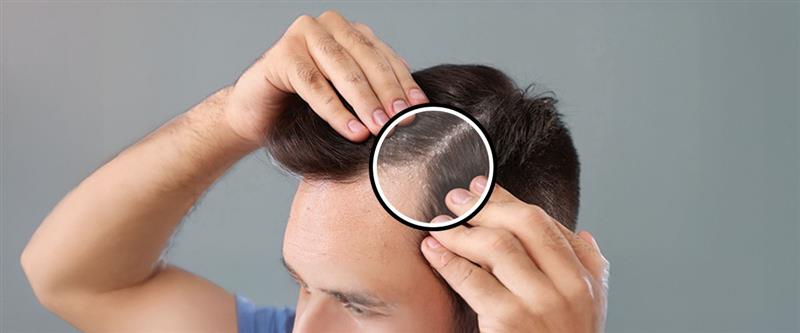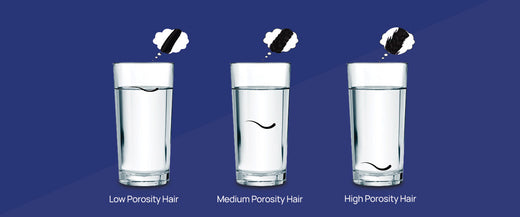Balding: Early Signs, Causes and Treatments
Evidence Based
All the information in this blog post is accurate, trustworthy, scientifically based and has been written and fact-checked by our experts and doctors.
Our licensed nutritionists and dietitians are committed to being objective, unbiased and honest, presenting all sides of the argument.
This article includes scientific references in brackets, which are clickable links to research papers from reputable academic organizations.

Balding can start at any age; However, early warning signs exist.
Are you on the lookout for signs of balding? Curious about the early signs? Look no further – this blog article is for you.
Hair loss is a common concern for many men, and it can start at any age. It is important to be able to recognize the early signs of balding so that you can take proactive measures and seek effective treatments. While some hair shedding is normal, there are specific indicators that can signal the onset of balding. This article will delve into the early signs of balding in men, its causes, and the available treatments.
What are the Early Signs of Balding?
Although losing some hair daily is considered normal, it's crucial to be mindful of significant changes in hair density and texture, as they could signal the development of a hair loss condition.
Here, we'll explore the 5 earliest signs of balding in young men:
1. Overall Thinning Hair:
It's common for men to experience thinning of hair all over their scalp, not just at the crown. Around 50% of men aged 50 and above experience such overall hair thinning due to the weakening of hair follicles with age. This can be another indication of male pattern baldness. The hair at the back of the head may also start thinning. Unfortunately, since we do not usually see it regularly, many men may overlook this sign of male pattern baldness.
2. Receding Hairline:
A receding hairline serves as an early indicator of hair loss. The initial signs manifest as thinning at the top of the head, resulting in a distinct widow's peak and a hairline that takes on the shape of either the letter M or a horseshoe. Alternatively, the thinning may extend uniformly across the entire frontal region.(Ref.)
3. Excessive Hair Loss:
The third sign that you might be experiencing balding is excessive hair fall, a key indicator of male pattern baldness. Many people dismiss this sign, thinking it's just a seasonal or natural occurrence. However, if you're noticing a lot of hair on your pillow, comb, or clothes, it could be a signal of male pattern baldness.
Stress hormones, like cortisol, can also contribute to this issue, causing not only a reduction in hair growth but also making your strands weaker, leading to increased shedding. On average, people lose about 100 hair strands a day, but losing hair in larger amounts may suggest the presence of androgenic alopecia. If you're concerned, you can explore hair loss solutions designed by experts for men.
4. Itchy Scalp:
The fourth indication of potential balding is an itchy scalp, although this is not common. In certain cases, persistent itching may be an indication of male pattern baldness. Excessive scratching of the scalp can weaken hair follicles, resulting in increased hair fall. It is recommended that men consult with a dermatologist to address this issue. If an in-person visit is not feasible, you have the option to speak with a dermatologist online. Click here to speak with a dermatologist.
5. Shorter Hair Growth Cycle:
Male pattern baldness is usually characterised by a shorter hair growth cycle. The reason behind this phenomenon is that when hair follicles shrink, the new hair that grows becomes thinner and the hair growth cycle becomes shorter. What this means is that the hairs grow and shed in a shorter time frame than they used to previously. If you notice that your hair is not growing at the same speed as before, it could be a sign of male pattern baldness.
How Much Hair Loss is Normal?
The normal range for daily hair loss is typically 50-100 strands, as our scalp houses over 100,000 hair follicles, allowing for this loss without noticeable thinning. Women tend to shed slightly more hair daily than men, with individual variations. Styling practices, like using straighteners or curling tongs, and the use of harsh chemicals in hair treatments, can impact the amount of hair shedding.
What are the Main Causes of Blading?
Male pattern baldness, also known as androgenetic alopecia, is the most common cause of hair loss in men. It is a hereditary condition that can be influenced by a combination of genetic and hormonal factors. The primary cause is believed to be the presence of dihydrotestosterone (DHT), a derivative of the male hormone testosterone.
Here are some key factors that contribute to early balding in men:
1. Genetics:
The most significant factor in male pattern baldness is genetics. If a man has a family history of baldness, especially on the maternal side, he is more likely to experience early balding himself.
2. Hormones:
Hormones, particularly androgens such as testosterone and DHT, play a crucial role in hair loss. DHT can shrink hair follicles, making them produce thinner and shorter hair until they eventually stop producing hair completely.
3. Age:
While male pattern baldness can start at any age, it often becomes more noticeable as men age. It's more prevalent in older age groups, but some men may experience early onset.
4. Diet and Lifestyle:
Poor nutrition and an unhealthy lifestyle can contribute to hair loss. A diet lacking essential nutrients, especially those important for hair health (such as vitamins and minerals), can impact the strength and vitality of hair.
[ Read: Top 13 DHT Blocker Foods for Healthy Hair Growth ]
5. Stress:
While stress alone is not a direct cause of male pattern baldness, it can cause hair loss in individuals who are genetically prone to it. In certain cases, high amounts of stress might initiate or speed the process.
6. Medical Conditions:
Certain medical conditions, such as thyroid disorders, autoimmune diseases, and hormonal imbalances, can contribute to early balding. Treating the underlying medical condition may help slow down or reverse hair loss.
7. Medications:
Hair loss is a common side effect of some medications, such as those used for cancer, arthritis, depression, gout, heart problems, and high blood pressure.
8. Traction Alopecia:
Hairstyles and the frequent use of different gels or hair dryers can cause traction alopecia a kind of hair loss. Constant stress on the hair follicles can lead to damage and, over time, permanent hair loss.
What are the Treatments Available for Hair Loss?
If you’re experiencing male pattern hair loss, there are various methods you can take to stop male pattern hair loss and increase hair growth. The only FDA-approved medications are minoxidil and finasteride (Propecia), but other treatments are effective in some cases. (Ref.)
1) Finasteride (Propecia):
An FDA-approved oral prescription, Propecia slows hair loss and fosters regrowth in men with androgenic alopecia by blocking the conversion of testosterone to DHT. It boasts an 83% success rate over two years but should be avoided by women who could become pregnant.
2) Minoxidil (Rogaine):
Topically applied in liquid or foam, Minoxidil takes about four months for visible results. Combining it with finasteride enhances effectiveness in preventing hair loss.
3) Hair Growth Serums:
Tired of searching for the perfect serum? Give ForMen Hair Growth Serum a shot! It's got a winning combination of Redensyl, Procapil, Saw Palmetto, and many proven natural ingredients for effective hair growth. For better results, doctors recommend using it regularly for 3-6 months and pairing it with a healthy diet and enough sleep for the best results.
4. Low-level laser therapy (LLLT):
FDA-cleared for hair loss, LLLT's mechanism is unclear but may stimulate new hair growth by activating follicle stem cells.
5. DHT-Blocking Shampoo:
While less potent than other treatments, some shampoos with ingredients like ketoconazole may improve efficacy when combined with finasteride. If you are searching for the best shampoo to boost density and reduce hair fall, then try ForMen Hair Growth Shampoo! It has covered all your hair growth needs. Transform your hair care routine and unlock a healthier, more voluminous you.
6. Platelet-Rich Plasma (PRP) Treatments:
Despite varying study results, PRP, using a patient's processed blood, aims to stimulate hair growth but is not FDA-approved for hair loss.
7. Hair Transplants:
A surgical procedure relocating hair, transplants yield significant results, especially for receding hairlines and androgenetic alopecia.
Hair loss is a common occurrence as we age, but certain health conditions and medications can also lead to balding. Since hair loss usually occurs gradually, it may take years for your hair to start changing. To get greater and more effective results, try the safe and doctor-recommended ForMen Growth Serum.
Also Read the Articles:
- Redensyl vs Minoxidil: Which is Good for Hair Growth?
- Top 10 Best Shampoos for Hair Growth in Men
- Different Types of Male Pattern Baldness
- How to Get Rid of Dandruff and Prevent Hair Fall?
- Telogen Effluvium Symptoms, Causes, Diagnosis and Treatment
| *** This Article is Written by Swetha Ramala. |
Disclaimer: The information provided on this page is not a substitute for professional medical advice, diagnosis, or treatment. If you have any questions or concerns about your health, please talk to a healthcare professional.

 Evidence Based
Evidence Based






Leave a comment